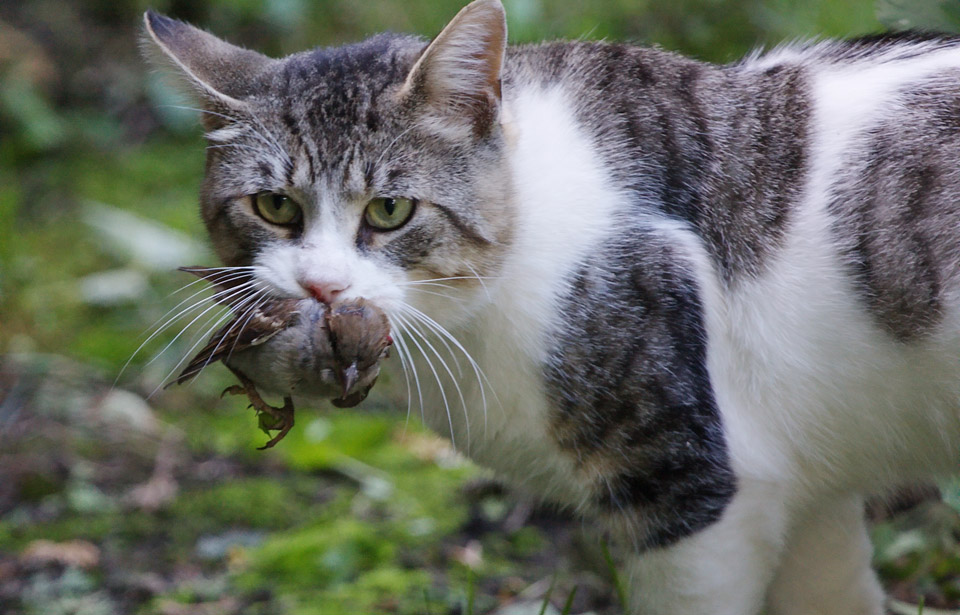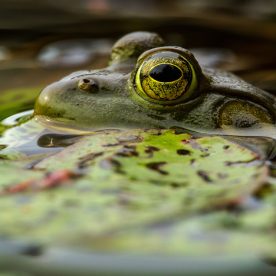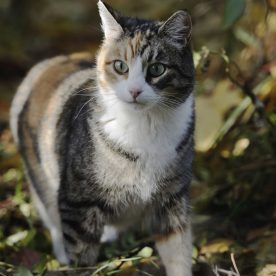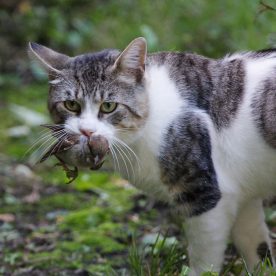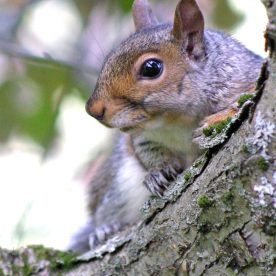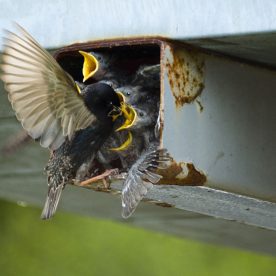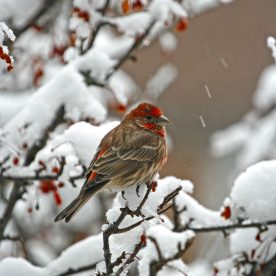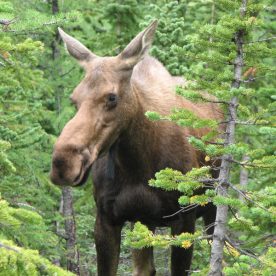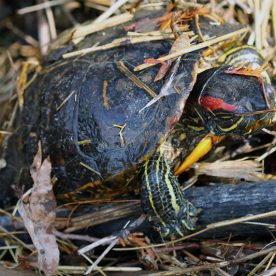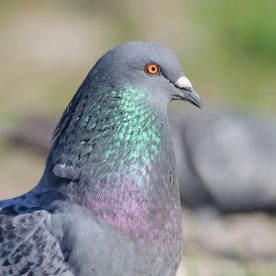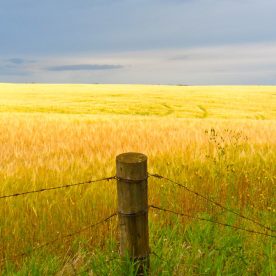Invasive Alien Species in Canada
- are brought into Canada accidentally and intentionally
- are one of the main threats to biodiversity
- are very difficult to control
What are invasives?
Canada is being invaded by aliens, but not by the type you see in science fiction movies. These organisms are found nearly everywhere in Canada. They can belong to any of the categories of organisms in the world, including plants, mammals, birds, reptiles, amphibians, invertebrates, and micro-organisms. They include species native to one part of Canada that move to another region of the country, as well as those that come from outside the country. These aliens are any species that has spread beyond its natural range into new locations as a result of human activity.
You are already well acquainted with some alien, or non-native, species. For example, lawns and gardens are made up mostly of alien species, including Kentucky bluegrass, periwinkle, lily of the valley, and even the unwanted dandelion. The domestic cat is thought to have originated in Africa. And the pigeon and the European Starling, birds commonly seen in Canadian cities, both came from Europe. Even many of the foods you eat originated in other countries. Potatoes came originally from the South American Andes, corn from Mexico, and wheat from Africa and the Middle East.
There are also many examples of species from one part of Canada that have taken up residence in another. The familiar moose, for example, is native to most parts of the country, but is an introduced species on the island of Newfoundland, as are the red squirrel and the snowshoe hare. The bullfrog is native to some provinces, but is an alien species in British Columbia. And the House Finch, which originated in several western provinces, is now found in a number of provinces in the east.
Many of Canada’s alien species are beneficial, but a great number are not. Sometimes the conditions are right for alien species to become invasive—they move into new habitats and take over, their populations sometimes expanding beyond control. The harm they cause to the environment, the economy, or human health can be costly and sometimes irreversible.
Source of invasives
Where do they come from and how do they get here?
Alien species come into Canada by any means of transport that moves them farther than they could move on their own. Sometimes they are brought in on purpose, but often they arrive unintentionally.
Seafaring European explorers and settlers were the first to introduce new species to Canada. They brought cattle, goats, and other domestic animals, along with familiar crops like wheat, when they came by ship to explore and settle the New World. Without meaning to, they also introduced unwanted organisms—pests, like the Norway rat, and viruses, like deadly influenza and smallpox.
Today, alien species are still being imported intentionally into Canada from around the world for use in many areas, from agriculture and horticulture to the pet trade to medical and scientific research. A variety of legislation regulates the importation of alien species into Canada and their movement once they are in the country. Unfortunately, even when programs are in place to monitor and contain imported species, the effects the species can have on the environment if they accidentally escape from their intended habitat is not always considered.
It is more difficult to trace the pathways of species that have been introduced accidentally than it is those introduced intentionally. Accidental arrivals are rarely discovered until they have become invasive and spread some distance from their point of entry. For example, many unwanted aliens arrive in ballast water, the seawater or freshwater used to stabilize large ships during travel; aquatic species are taken up along with ballast water at one port and released at the destination port. About half of the alien shellfish species in Canada, including the highly invasive zebra mussel, probably arrived in North America in this way. Shipping-crate wood and packing materials may also contain unwanted species, such as insects. As well, unwanted aliens may travel with intentionally imported ones. For example, plants, seeds, and bulbs that are imported for use in landscaping may harbour foreign insects and fungi or may be contaminated with the seeds of other plants. Domestic animals and aquaculture species may carry foreign diseases or parasites.
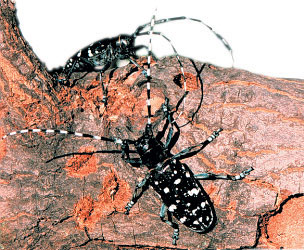
Asian long-horned beetles.
Photo: Kenneth R. Law
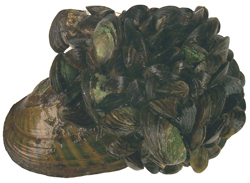
Zebra mussels attached to a native freshwater mussel.
Photo: Yves de Lafontaine
Alien introductions into Canada are becoming more frequent and difficult to track as global trade and travel expand. Europe used to be the main area of origin of alien species. In recent years, more species have been arriving from Asia, some with telltale names like the Asian long-horned beetle, Japanese bamboo, and Eurasian water milfoil. More frequent travel between regions within Canada is also speeding up the spread of alien species to remote areas, isolated water bodies, and islands.
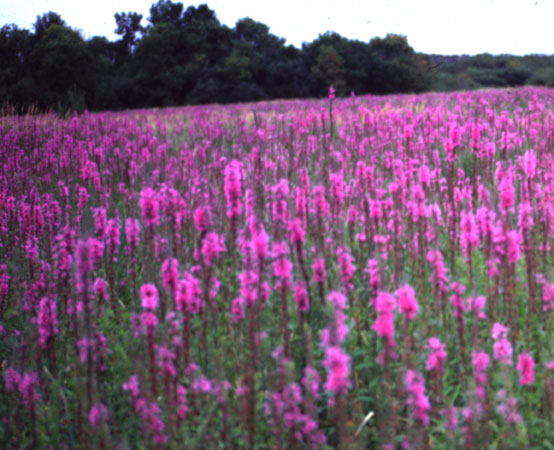
Purple loosestrife, introduced from Europe in the early 1800s as a garden ornamental plant, has invaded wetlands throughout eastern North America, edging out many native species. Wetlands are the most biologically diverse part of our ecosystem. When the purple flower chokes out habitat, it affects hundreds of species of plants, birds, mammals, reptiles, insects, fish, and amphibians that rely on wetlands to survive. Only three provinces prohibit the sale of purple loosestrife; it can still be purchased in garden centres everywhere else in Canada.
Photo: Cory Lindgren
Concerns
Why are we concerned?
When an alien species enters an ecosystem, it can have an impact on the species that are present, on important habitats, or even on the ecosystem itself. Concern arises when an alien species changes the system for the worse, either by reducing or eliminating populations of native species, or by otherwise changing the way the ecosystem works.
These changes have made the invasion of alien species a major global problem. If organisms were not able to move beyond their normal ranges, each part of the world would have a unique array of plants, animals, and micro-organisms. But as species move from one area of the world to another, sometimes squeezing out the competition, different places in the world become more alike in their biology—a process called biological homogenization.
This process is undesirable because as it takes place, ecosystems often become less stable, and valuable biodiversity, or variety of life, is lost. This variety is essential to the health of our planet; each species performs a function that contributes to global well-being. The spread of invasive alien species, like habitat loss, is considered one of the major threats to biological diversity. Invasive alien species have obliterated about 110 vertebrate species around the world and have affected nearly every type of ecosystem. For example, in New Zealand, predatory European mammals such as rats, cats, and stoats have caused the extinction of nine native bird species, and they threaten many more. In Guam, the brown tree snake, an import that arrived hidden in ship cargo from New Guinea, has wiped out virtually all the island’s native forest birds.
In Canada, about 5 percent of mammal species and 27 percent of vascular plant species are aliens. The number of many other alien species is not yet known.
Invasive aliens pose a problem mainly in places with a warmer climate and a disturbed landscape. In Canada, these two factors come together in the south, where most of the human population lives. Urban and industrial development and activities such as forestry and agriculture disturb the landscape in ways that make it more vulnerable to alien invasions and endangerment of native species. In particular, southern British Columbia, Ontario, and Quebec are home to a large number of both invasive aliens and species at risk. Natural communities on islands are also particularly vulnerable to invaders. Their plants and animals have evolved in isolation from the mainland, and they do not have the adaptations needed to escape from or compete with outsiders. Almost half the mammal species found on the island of Newfoundland and on the Queen Charlotte Islands are invasive aliens.
The cost of the damage caused by invasive alien species in Canada and the cost of controlling these species is not precisely known. But these costs are considerable and will continue to grow. Forestry companies and farmers lose millions of dollars in products each year because of alien pests and disease, and they spend millions more on pesticides, fungicides, and herbicides to control the invaders. Another example involves an aquatic invader. Tens of millions of dollars have already been spent repairing the damage caused by the zebra mussel to industrial intake and output pipes and to locks and other waterway structures in the Great Lakes system. Unless checked, further damage by this invasive mollusc over the next 10 years is expected to cost Canada and the United States another $5 billion. Invasive aliens also take a toll on health. The West Nile virus, for example, a disease transmitted by infected mosquitoes, has caused numerous deaths in humans and wildlife in Canada and the United States since it was first detected in North America in 1999.
How invasives thrive
Aliens that are successful invaders are species that have some advantage over native species. These advantages are often enhanced when aliens move into ecological niches and thrive because, outside their natural environments, they are not held back by natural predators, parasites, disease, or competition in the way that native species are. Here are some Canadian examples of how alien species affect the species around them:
Competition: In many cases, invasive aliens out-compete native species for space, water, food, and other essential resources. For example, non-native starlings eliminate native Canadian birds like bluebirds, Red-headed Woodpeckers, and Tree Swallows by taking over their nesting sites. In addition, often aliens reproduce more successfully than indigenous species, quickly outnumbering the natives.
Many threatened and endangered species are placed at grave risk by invasive aliens. An estimated 16 percent of endangered plants in Canada are negatively affected by competition with invasive alien plant species. For example, endangered native white wood aster, ginseng, and wood poppy are all threatened by the invasion of non-native garlic mustard.
Predation: Some invasive aliens cause native populations to decline by being aggressive herbivores or predators – defoliating or overgrazing native plants or preying on native animals. Introduced rats and raccoons eat the eggs and nestlings of Ancient Murrelets and other seabirds living on the coast of the Queen Charlotte Islands. By depleting this population, the aliens may also be affecting the vulnerable Peale’s Peregrine Falcon, for which Ancient Murrelets are a food source. Another invasive, the gypsy moth, defoliates, or eats the leaves of, many tree species. This causes widespread damage to Canadian forests and huge losses to the forest industry.
Disease: Sometimes, invasive alien species are diseases. Chestnut blight, a fungal disease that came to North America on nursery stock from Asia around 1900, has devastated the population of American chestnut trees in eastern Canada and the United States.
Parasitism: At times, invasive alien species feed on, or parasitize, native species, severely weakening them but not necessarily killing them. The sea lamprey, which parasitizes other fish, was introduced into the upper Great Lakes in the 1800s and early 1900s. Along with other factors, it was responsible for severely reducing the native population of lake trout, the system’s top natural predator.
Hybridization: Sometimes invasive aliens weaken the gene pool of native species by interbreeding with them, a process called hybridization. In southwestern Ontario, native red mulberry is imperilled by hybridization with the alien white mulberry, brought to Canada from China in an attempt to start a silk industry here. With continued hybridization, the gene stock of the red mulberry is becoming diluted. There are now as many stands of hybrid mulberry as red mulberry.
Habitat alteration: When they change the structure or composition of a habitat, invasive alien species make it unsuitable for other species. This process is called habitat alteration. Careful management of the introduced moose is required to prevent overgrazing of forests and wetlands on the island of Newfoundland. Foresters in areas that are overpopulated by moose find that the animals’ grazing harms the regrowth of forest trees. This may seriously reduce future timber crops as well as the breeding habitat of songbirds that nest in deciduous shrubs. Overgrazing can also expose low-nesting birds and leave them vulnerable to predation.
Alien species can also seriously affect the environmental processes that all species, including humans, depend on. For example, the alien aquatic plant Eurasian water milfoil forms dense mats along shorelines and in slow-moving rivers. These mats sometimes interfere with the local nutrient cycle. When they die and decay, large amounts of phosphorus are added to the water, making it too rich in nutrients.
Slowing the spread
What can be done?
Cooperation
The problem of invasive alien species is so large that it cannot be properly dealt with unless groups and countries work together to monitor the progress of invasive aliens and come up with solutions. Experts from many countries are now cooperating on programs like the Global Invasive Species Program to help develop a worldwide plan to deal with this problem.
An increasing number of countries around the world are also creating individual strategies and action plans on invasive alien species. In Canada, a comprehensive national plan to address the threat of invasive alien species, including invasive aquatic and terrestrial animal and plant species, is now being developed through the collaboration of federal, provincial, and territorial governments. In addition, many government and nongovernment groups run projects to monitor and control invasive alien species. For example, Environment Canada’s EcoAction program supports community projects across the country to monitor and eradicate purple loosestrife and other invasive aliens.
Prevention
By the time invasive aliens are detected, their populations have grown significantly, and they have usually spread far from their point of introduction. Controlling them at this stage is very difficult, sometimes impossible; it is better to prevent them from coming into the country. Over the years, Canada has instituted many laws, regulations, and policies aimed at achieving that goal.
In 1992 Canada joined the United Nations Convention on Biological Diversity. This international agreement aims, among other things, to prevent the introduction of alien species that threaten ecosystems and to control or get rid of alien species that are already established. Under this agreement, Canada developed the Canadian Biodiversity Strategy in 1995. This strategy supports monitoring and controlling the importation of alien species.
Keeping Canada’s ecosystems healthy and undisturbed is another way to help slow the advance of invasive aliens or prevent them from becoming a nuisance.
Targeted control
Keeping all alien species out of Canada is not practical, even though it would help us conserve our natural ecosystems. For one thing, enforcing Canada’s laws and guidelines about alien species is very difficult. For example, only about 1 to 2 percent of shipments arriving at Canada’s borders are inspected for alien species, so there is a great chance that accidental introductions will happen. Another consideration is Canadians’ desire to have a variety of foods, up-to-date medicines, non-native pets, and strong scientific research programs, so that some importation of alien species must be allowed.
Canada’s laws prohibit some species from entering the country. Others are allowed in after they have been assessed, reducing the risk that alien species will become invasive and cause environmental and economic losses. However, it is not easy to predict how invasive and damaging a species will be before actually observing it “in action.” Once an alien species is established, some type of control may be necessary to reduce the harm it can do. Because resources are limited, decisions must be made about which invasive aliens cause the most harm and need the most control. Here are the four main methods used to control alien populations, along with some examples of how they are used in Canada:
Physical control: Physically removing the species from its environment includes pulling out unwanted plants by hand or machine; tilling soil; burning an area; and snaring, trapping, and shooting unwanted animals. An example of this is burning off invasive plants to restore a natural prairie grassland.
Chemical control: Pesticides, herbicides, fungicides, and other chemicals are used to kill target alien species on contact or to indirectly kill them or their offspring by damaging their essential life processes or ability to reproduce. An example is the use of poison to eradicate rats from Langara Island, one of the Queen Charlotte Islands. Chemical control was widely used in the past but is now used less because of possible harmful effects on non-target species, both wildlife and human.
Biological control: Living organisms, particularly predators, parasites, and disease, are used to control the growth of alien populations. Many organisms used to control alien species in Canada are aliens themselves – prey-specific predators brought in from the natural range of the species being controlled. An example is the introduction of host-specific plant-eating insects or parasites to control leafy spurge, purple loosestrife, and gypsy moth.
Integrated control: This involves a combination of control methods, changes in land use practices, and preventative methods like habitat rehabilitation that are used to control alien species and to prevent their recolonization. An example is the use, by Parks Canada, of a variety of control methods to carry out the agency’s job of protecting the ecological health of Canada’s national parks system.
Monitoring, research, and education
People in Canada have only recently begun to keep track of alien species and invasives. Continued work is needed to monitor the arrival and progress of alien species in Canada. Researchers must also learn more about what allows a species to become invasive and which controls are the most effective. To fill these and other gaps in our knowledge and to produce materials on invasive alien species that are useful for scientists and ordinary citizens, much work will be required.
As people become more aware of the problem of invasive aliens, they will be more likely to make good decisions to help prevent and deal with this problem. Publications like this one inform teachers, students, and other interested Canadians about the problem. Conservation groups can help get the message out to their members. Industry groups, like nurseries and pet stores, can become more aware of the role they play in introducing alien species to Canada.
How to help
How can you help?
Individuals are responsible for the introduction of many alien species to Canada. You can do your part to help prevent further invasions by following these principles:
- Do not release alien plants or animals (including pets and live bait) into the wild.
- Do not bring fruit, vegetables, plants, or animals with you across international borders. Be cautious about what you carry across interprovincial borders.
- Before taking a recreational trip, inspect and clean fishing equipment, boats, trailers, recreational vehicles, and other items that may harbour hitch-hiking invaders.
- Do not transport over long distances firewood or other wood with bark attached.
- Learn which plant species are invasive, and remove them from your garden. See the resources list at the end of this fact sheet for information on some invasive alien plant species. Take special care with water garden plants, as many are invasive. Be aware that native grass or wildflower seeds sold through seed catalogues sometimes include seeds from alien species. If you are unsure about a new species, plant it where you can easily control its spread, and remove it if necessary. Avoid planting alien species next to, or within, natural areas, roadsides, or forested fence rows.
- Keep natural habitats on your property healthy.
- Volunteer with local environmental organizations that work to maintain healthy ecosystems or restore degraded ecosystems.
- Know where consumer products come from (especially food, pets, and biological pest-control products). Buy from local sources where possible, and be particularly cautious about purchasing from Internet-based companies.
Resources
Online resources
Canadian Endangered Species Conservation Council — Wild Species 2000: The general status of species in Canada
Federation of Ontario Naturalists, Natural Invaders
United States Environmental Protective Agency – Invasive Species in the Great Lakes
Invasive Plants of Canada Project
IUCN (World Conservation Union) Invasive Species Specialist Group; includes the booklet 100 of the World’s Worst Invasive Alien Species
The Nature Conservancy (United States) — Invasive Species Initiative
Ontario Federation of Anglers and Hunters — Invading Species
United States National Invasive Species Council
Print resources
Canadian Forest Service and Natural Resources Canada. 1999. Alien forest pests: Context for the Canadian Forest Service’s Science Program. Science Branch, Canadian Forest Service, Ottawa.
Claudi, R., P. Nantel, and E. Muckle-Jeffs, editors. 2002. Alien invaders in Canada’s waters, wetlands, and forests. Natural Resources Canada, Ottawa. (Summary available atNatural Resources Canada.)
Mooney, H.A., and R.J. Hobbs, editors. 2000. Invasive species in a changing world. Island Press, Washington, D.C.
Pimentel, D., L. Lach, R. Zuniga, and D. Morrison. 2000. Environmental and Economic Costs of Nonindigenous Species in the United States. BioScience 50: 53–65.
Stein, B.A., and S.R. Flack, editors. 1996. America’s least wanted: Alien species invasions of U.S. ecosystems. The Nature Conservancy, Arlington, Virginia.
© Her Majesty the Queen in Right of Canada, represented by the Minister of the Environment, 2003. All rights reserved.
Catalogue number CW69-4/102-2003E-IN
ISBN 0-662-34263-1
Text: Michelle Lee and Mark Hovorka
Editing: Joan Gregorich and Maureen Kavanagh
Photos: Cory Lindgren (purple loosestrife); Yves de Lafontaine (zebra mussels); Kenneth R. Law, USDA, APHIS, Plant Protection and Quarantine, Newburgh, New York (Asian long-horned beetle)



